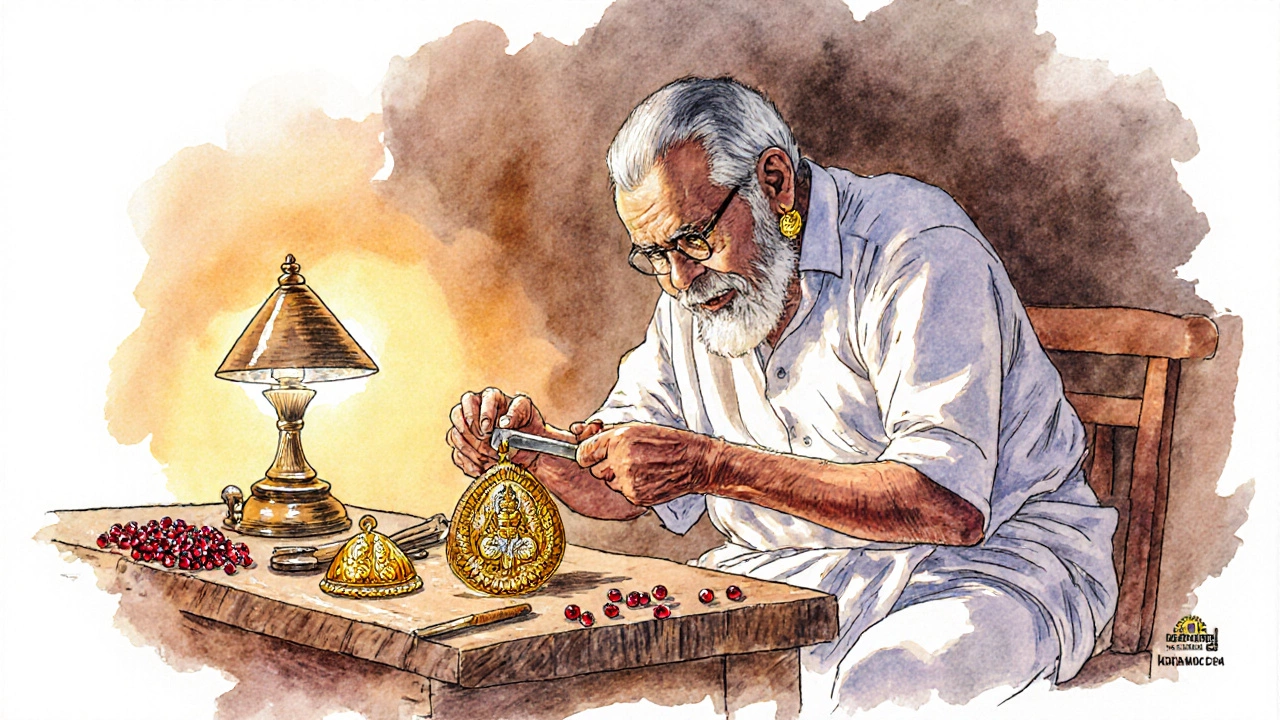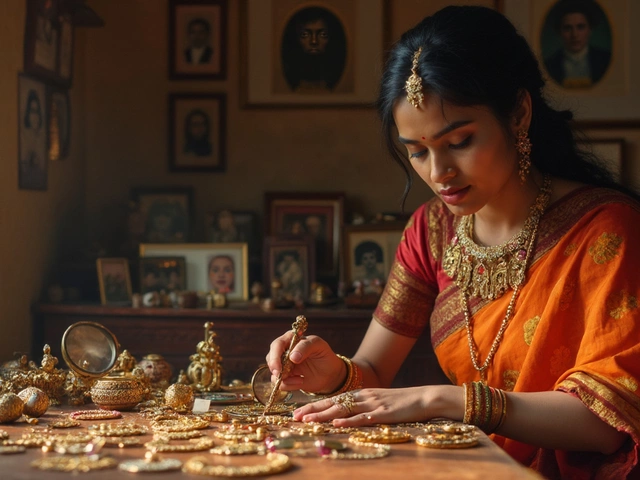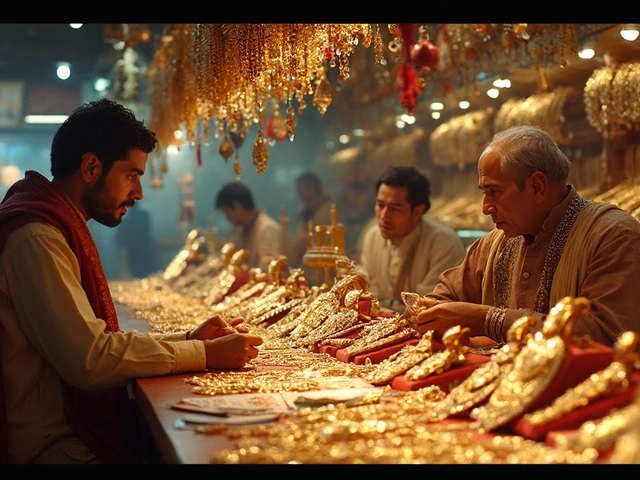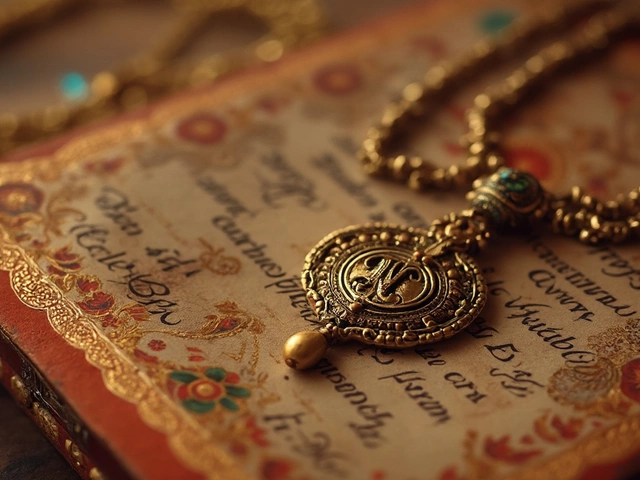Temple Jewelry Price Estimator
This calculator estimates the price range for authentic temple jewelry based on weight, gold purity, and complexity. Prices reflect handcrafted heritage pieces from artisan communities in South India.
Estimated Price Range
Gold jewelry in India isn’t just an accessory-it’s heritage worn on the skin. In 2024, the biggest shift isn’t in carat weight or diamond accents. It’s in the return of temple jewelry. Once reserved for temple dancers and royal ceremonies, this intricate gold art is now everywhere-from wedding day looks to Instagram feeds in Bengaluru and Delhi. Women aren’t just buying jewelry; they’re reclaiming identity.
Why temple jewelry is back in a big way
Temple jewelry didn’t disappear. It was pushed to the sidelines during the 1990s and 2000s, when Western styles and minimalist gold chains took over. But in 2024, something changed. Young women, especially those aged 22 to 35, started asking for pieces their grandmothers wore. Not as costumes. Not as props for festivals. But as everyday luxury.
The trigger? A mix of cultural pride and social media. TikTok and Instagram reels showing Bharatanatyam dancers in full temple jewelry sets went viral. Designers like Sabyasachi and Amrapali didn’t just copy old patterns-they reimagined them. Lighter weights. Smaller motifs. Clasps that won’t snag on silk sarees. The result? A piece that feels sacred but fits into modern life.
According to data from the Gem & Jewellery Export Promotion Council, temple jewelry sales rose 37% year-over-year in 2024. That’s not a niche spike. That’s a cultural reset.
What makes temple jewelry different from regular gold jewelry
Temple jewelry isn’t just gold shaped into flowers and peacocks. It’s a language. Each element has meaning.
- Devi motifs: Goddess Lakshmi, Durga, or Saraswati carved into pendants-symbolizing protection and prosperity.
- Kempu stones: Red garnets, not diamonds, are the traditional gemstone. They’re cheaper, more authentic, and glow under temple lights.
- Repoussé work: Gold is hammered from the back to create raised patterns. No casting. No molds. Every piece is hand-forged.
- Chains with temple bells: Small jingling bells on earrings or necklaces-meant to sound like temple bells during dance.
Compare that to today’s standard gold chain or solitaire. Those are mass-produced. Temple jewelry takes 3-6 weeks to make. One artisan might spend 40 hours on a single jhumka. That’s why prices start at ₹25,000 and go up from there.
The new twist: temple jewelry for non-traditional occasions
Here’s the real story of 2024: temple jewelry is no longer just for weddings or temple visits. It’s showing up at office parties, art gallery openings, and even casual brunches.
Designers are breaking rules. A gold temple-style hairpin with a single kempu stone? Perfect with a blazer and jeans. A miniature temple pendant on a thin gold chain? Now worn as a daily talisman. Even men are wearing small temple-inspired brooches on sherwanis.
One Mumbai-based designer, Priya Mehta, told me her best-selling item this year is the “Mini Kavach”-a 2.5-gram gold pendant shaped like a temple gopuram. It’s 40% lighter than traditional pieces and comes with a magnetic clasp. She sold 1,200 units in six months. Customers aren’t buying for dowry. They’re buying because it makes them feel connected.

Where to find authentic temple jewelry in 2024
Not every “temple jewelry” piece you see online is real. Many are machine-made with low-karat gold and synthetic stones. Here’s how to tell the difference:
- Check the weight: Authentic temple jewelry is dense. A pair of earrings should feel substantial, not hollow.
- Look for hand-hammered texture: Real repoussé work has tiny ridges and uneven surfaces. Machine-made pieces are too smooth.
- Ask for hallmark: BIS 916 hallmark is non-negotiable. If they don’t show it, walk away.
- Trace the origin: The best pieces still come from Chettinad in Tamil Nadu, Kanchipuram, or parts of Andhra Pradesh. Avoid brands that say “inspired by” without naming the craftsperson.
For trustworthy sources, look at: Amrapali (Jaipur), Vanaja (Chennai), Khazana (Hyderabad), and Chola Heritage (Tamil Nadu). These brands work directly with artisan families who’ve passed down the craft for 4-5 generations.
Price range and what you’re actually paying for
Temple jewelry isn’t cheap. But it’s not just gold. You’re paying for time, skill, and history.
| Item | Weight (g) | Gold Purity | Price Range (₹) | Time to Make |
|---|---|---|---|---|
| Small kundan jhumka | 8-10 | 22K | 25,000-35,000 | 2-3 weeks |
| Temple necklace (choker) | 25-30 | 22K | 85,000-1,20,000 | 4-6 weeks |
| Full set (necklace, earrings, bangles, hairpin) | 80-100 | 22K | 3,00,000-5,00,000 | 3-4 months |
| Mini pendant (daily wear) | 2-3 | 22K | 18,000-25,000 | 1-2 weeks |
Compare that to a mass-produced gold chain from a mall brand. You might pay ₹15,000 for 10 grams of 22K gold. But you’re not paying for craftsmanship. You’re paying for branding. Temple jewelry? You’re paying for a legacy.

Why this trend matters beyond fashion
Temple jewelry isn’t just a style. It’s a lifeline for over 12,000 artisans in South India. Many of them are from communities that have practiced this craft for centuries. Their skills are fading. Younger generations don’t want to spend 10 hours a day hammering gold.
But in 2024, demand is bringing them back. Artisans in Kanchipuram now have apprentices. Cooperatives are forming. NGOs are helping them get GST registration and sell online. This trend isn’t just about looking beautiful. It’s about keeping history alive.
When you wear a temple jewelry piece today, you’re not just accessorizing. You’re supporting a craft that survived colonialism, industrialization, and fast fashion. That’s powerful.
How to style temple jewelry without looking overdressed
You don’t need a silk saree to wear temple jewelry. Here’s how to make it work:
- Pair a single temple jhumka with a simple cotton kurta and jeans. Let it be the only statement.
- Wear a mini temple pendant over a turtleneck. The contrast of ancient art on modern fabric is striking.
- Stack two thin gold chains with one temple pendant in the center. It softens the look.
- Don’t mix with other heavy jewelry. Temple pieces are bold on their own.
- For daytime, choose pieces with kempu stones in smaller sizes. Avoid large, ornate sets until evening.
One client in Pune told me she wears her temple hairpin every Monday. “It’s my version of a power tie,” she said. That’s the new normal.
Future of temple jewelry: Will it last?
Will this trend fade by 2025? Probably not. Why? Because it’s not a trend. It’s a rediscovery.
Young Indians are rejecting the idea that tradition has to be heavy, loud, or outdated. They want beauty with meaning. Temple jewelry delivers that. It’s handmade, culturally rooted, and emotionally resonant.
Some designers are even experimenting with recycled gold and lab-grown kempu stones. Sustainability is creeping in. That’s the next phase.
One thing’s certain: in 2024, gold in India didn’t just sparkle. It spoke. And people finally listened.
Is temple jewelry only for weddings in 2024?
No. While temple jewelry is still popular for weddings, it’s now worn daily by younger women across India. Designers have created lighter, smaller versions-like mini pendants and slim jhumkas-that fit into modern wardrobes. Many wear them to offices, cafes, and even casual outings.
How can I tell if temple jewelry is authentic?
Look for three things: hand-hammered texture (not smooth), BIS 916 hallmark, and the use of kempu stones (red garnets), not diamonds. Real temple jewelry is made using repoussé technique, which leaves subtle ridges. Avoid pieces that feel too light or have plastic-looking stones. Buy from brands that name their artisans or source from Chettinad, Kanchipuram, or Andhra Pradesh.
Why is temple jewelry so expensive?
You’re not just paying for gold. You’re paying for 40-60 hours of handcrafting by master artisans. Each motif is hammered, not cast. Stones are set by hand. No machines are used in traditional pieces. A single jhumka can take weeks. The price reflects skill, time, and cultural heritage-not just material cost.
Can men wear temple jewelry?
Yes, and more are doing it in 2024. Men are wearing small temple-inspired brooches on sherwanis, gold kavach pendants as necklaces, and even temple-style cufflinks. These pieces are usually minimalist-no large stones, just clean gold motifs. It’s a subtle nod to heritage without being overt.
What’s the difference between temple jewelry and kundan jewelry?
Temple jewelry uses repoussé goldwork with kempu stones and religious motifs like deities or temple towers. Kundan jewelry uses glass or gemstones set in pure gold foil, often with Mughal-style floral patterns. Temple jewelry is rooted in South Indian temple art; kundan comes from North Indian royal courts. Both are traditional, but their origins and styles differ.
Is temple jewelry a good investment?
Yes, if you buy from trusted artisans or heritage brands. Unlike mass-produced gold, temple jewelry holds cultural value that can appreciate. Many families pass down these pieces as heirlooms. The craftsmanship adds to its worth beyond the gold price. However, resale value depends on condition and provenance-keep the hallmark and purchase receipt.



